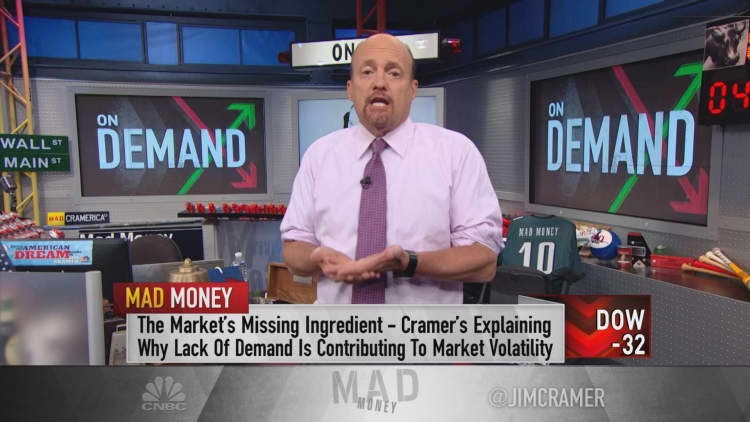
Strong demand is the one thing the market is missing, Jim Cramer says.
"Among the many reasons why we have developed this vicious volatility of late is the belief that demand is waning in many industries just when the Fed wants to tighten, hence why we ultimately drifted lower again today," the "Mad Money" host said.
On the flipside, if demand is not declining rapidly, then investors can tough out the market.
Cramer heard the concerns about lack of demand everywhere at CNBC's Delivering Alpha conference this week. It seemed to him that the vast majority of speakers had written off the prospect of robust growth in demand, either in the U.S. or overseas.
"I view things differently. While I have a macro worldview … I am a bottoms' up guy, a person who looks at demand company by company and makes an aggregate case based on the pastiche that I can put together," Cramer said.
While Cramer admitted that the worldwide demand worries him, he does not think it is dangerous. The systematic risk generated by banks in 2007 was perilous. That was a lot different than central bankers trying to stimulate demand by themselves like they are today.
Cramer found the demand in the U.S. challenged, but not dangerous. And no, he did not base his perspective on supply and demand on the price of oil. Often, money managers turn to oil as a measure of the health of the economy.
Cramer does not consider oil a proper barometer. When U.S. inventories drop, crude has a fleeting rally, and then a decline when investors recognize a glut still exists. Sometimes, crude even rebounds when countries that want prices higher spread rumors of an emergency OPEC meeting to freeze production.
"In other words, the price of oil is manipulated, it's bogus, and it has little-to-nothing to do with real demand that we need to calculate to make our worldview, even as it is the metric of choice for so many fund managers," Cramer said.
The same goes for metals, like copper and steel, to measure demand. Steel is also manipulated, Cramer said.
Instead, Cramer looked at employment, housing, non-residential construction, automobile stocks, retailers and demand for Apple.
The strength of employment encouraged Cramer, that is why he doesn't fear a rate hike as much as others. He also had positive sentiment on non-residential construction and the strength of housing.
"Based on the data, I think we don't have enough demand to keep this market from going lower, but we do have enough demand to contain the decline to levels that aren't dangerous," Cramer said.
That is why he recommended investors stay the course and then get back in at lower levels.
Questions for Cramer?
Call Cramer: 1-800-743-CNBC
Want to take a deep dive into Cramer's world? Hit him up!
Mad Money Twitter - Jim Cramer Twitter - Facebook - Instagram - Vine
Questions, comments, suggestions for the "Mad Money" website? madcap@cnbc.com



